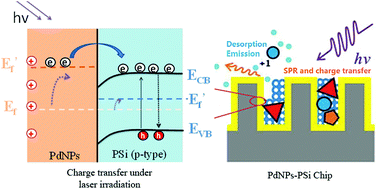Palladium modified porous silicon as multi-functional MALDI chip for serum peptide detection†
Abstract
Interest in using mesoporous materials for peptidomic research has increased recently. The present study reports a new type of matrix assisted laser desorption/ionization (MALDI) plate derived from electrochemically etched porous silicon (PSi) whose surface was modified with palladium nanoparticles (PdNPs). Owing to the well-tailored pore size and the molecular filtration effect of the PSi, peptides in serum samples can be selectively captured and enriched in the pore channel, thereby eliminating the interference from large proteins in subsequent MALDI-MS detection. On the other hand, the PdNPs with localized surface plasmon resonance (LSPR) effect can help to enhance the efficiency of energy absorption in the UV region. Meanwhile, the charge separation effect between the PSi semiconductor and PdNPs also can be applied to promote the accumulation of positive charges on PdNPs, resulting in an improvement in laser desorption/ionization (LDI) efficiency under positive linear detection mode. The interplay among these unique properties of PSi and PdNPs can synergistically increase the overall sensitivity in serum peptide detection. Using this technology, serum sample can be directly detected on the PSi-PdNPs chip without complicated pretreatment process. Therefore, a high fidelity serum peptide fingerprint can be acquired in a high throughput way. With the assistance of statistical analysis, colorectal cancer patients and healthy people can be accurately distinguished based on the serum peptide fingerprints.



 Please wait while we load your content...
Please wait while we load your content...